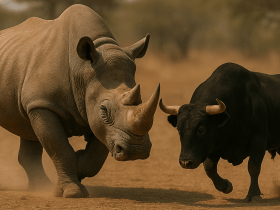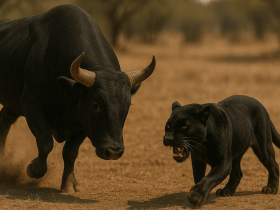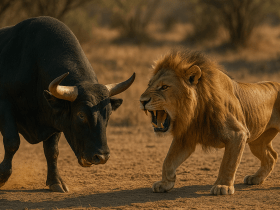Interesting topic right! . Polar bear Vs Gorilla who will win in a face to face fight?
- Polar bear (Ursus maritimus)
- Gorilla (Gorilla gorilla or Gorilla beringei)
Below tables I cover 10 main topics by including all the numerical and scientifical data by comparing Nile crocodile vs Rhino. Also I have included a winner column for further understanding,
Hope you will enjoy!
1. Body Specifications
| Feature | Polar Bear | Gorilla | Winner |
|---|---|---|---|
| Height (Standing) | Up to 3.0 m (male) | 1.5–1.8 m (male) | Polar Bear |
| Body Length | 2.4–3.0 m | 1.6–1.75 m | Polar Bear |
| Weight | 350–700 kg (male) | 140–200 kg (male) | Polar Bear |
| Shoulder Height | ~1.6 m | ~1.2 m | Polar Bear |
| Bone Density | Moderate | High | Gorilla |
| Muscle Mass Percentage | ~40% | ~40–45% | Gorilla |
| Chest Girth | ~2.0 m | ~1.5 m | Polar Bear |
| Arm Span | ~2.5 m | ~2.4 m | Tie |
| Skull Thickness | ~2.5 cm | ~1.5–2 cm | Polar Bear |
| Core Strength | Moderate | Extremely high | Gorilla |
Winner: Polar Bear (Larger, heavier, but Gorilla excels in compact muscle strength)
2. Coat and Coloration – Polar bear Vs Gorilla
| Feature | Polar Bear | Gorilla | Winner |
|---|---|---|---|
| Fur Color | White or creamy | Black to grayish | Tie |
| Fur Function | Insulation, camouflage | Protection, temperature regulation | Tie |
| Hair Density | Dense, 2 layers | Sparse compared to bears | Polar Bear |
| Melanin Level | Low | Moderate to high | Gorilla |
| Seasonal Shedding | Moderate | Minimal | Polar Bear |
| Skin Color | Black (for heat absorption) | Dark gray-black | Tie |
| Camouflage Ability | Excellent in snow | Poor | Polar Bear |
| Water Resistance | Yes (oily fur) | No | Polar Bear |
| Temperature Tolerance | -40°C to 10°C | 10°C to 30°C | Polar Bear |
| Grooming Behavior | Frequent in snow/water | Social grooming | Tie |
Winner: Polar Bear
3. Habitat and Range
| Feature | Polar Bear | Gorilla | Winner |
|---|---|---|---|
| Geographic Range | Arctic Circle | Central Africa | Tie |
| Habitat Type | Tundra, sea ice, coastal | Tropical forests, lowlands | Tie |
| Climate Preference | Freezing climates | Warm, humid | Tie |
| Range Size | Thousands of km² | Small, localized ranges | Polar Bear |
| Habitat Adaptability | Poor (specialist) | Moderate | Gorilla |
| Elevation Range | 0–300 m | 0–3,000 m | Gorilla |
| Human Conflict Zones | Increasing | High | Tie |
| Urban Tolerance | None | Very low | Tie |
| Habitat Threats | Climate change | Deforestation | Tie |
| Migration Patterns | Seasonal movement on ice | None | Polar Bear |
Winner: Tie (Different habitats and adaptations)
4. Diet and Hunting – Polar bear Vs Gorilla
| Feature | Polar Bear | Gorilla | Winner |
|---|---|---|---|
| Diet Type | Carnivore (99% meat) | Herbivore (mostly) | Tie |
| Common Foods | Seals, fish, whales | Fruits, stems, leaves | Tie |
| Hunting Technique | Stalk and ambush | None | Polar Bear |
| Prey Size | Very large (e.g., seals) | None (non-hunting) | Polar Bear |
| Hunting Success Rate | 10–20% | N/A | Polar Bear |
| Tool Use | None | Occasional | Gorilla |
| Caloric Intake | 12,000 kcal/day | ~4,000–6,000 kcal/day | Polar Bear |
| Foraging Behavior | Solo, long-range | Social, close-range | Tie |
| Aggressiveness for Food | High | Low | Polar Bear |
| Feeding Duration | Long, slow eaters | Fast, frequent | Tie |
Winner: Polar Bear
5. Strength and Bite Force
| Feature | Polar Bear | Gorilla | Winner |
|---|---|---|---|
| Bite Force (PSI) | ~1,200 PSI | ~1,300 PSI | Gorilla |
| Claw Size | 5–7 cm | Short nails | Polar Bear |
| Claw Strength | Extremely high | Low | Polar Bear |
| Arm Strength | High | Exceptional (can lift ~900 kg) | Gorilla |
| Grip Strength | Moderate | ~400 kg force | Gorilla |
| Lifting Power | Can drag 500+ kg prey | Can lift over 4× body weight | Gorilla |
| Slamming Force | High (with paws) | Very high (hammer fists) | Tie |
| Crushing Ability | Massive jaws and limbs | Strong arms and jaws | Polar Bear |
| Neck Strength | Thick, powerful | Moderate | Polar Bear |
| Overall Raw Power | Extreme | Extreme | Tie |
Winner: Tie (Gorilla edges out in arm power; polar bear dominates with claws and jaws)
6. ⚡ Speed and Agility
| Feature | Polar Bear | Gorilla | Winner |
|---|---|---|---|
| Top Speed | 40 km/h | 40 km/h | Tie |
| Acceleration | Moderate | Fast | Gorilla |
| Stamina | Low (bursts only) | High | Gorilla |
| Tree Agility | Cannot climb | Expert climber | Gorilla |
| Swimming Speed | 10 km/h | Poor swimmer | Polar Bear |
| Ground Maneuverability | Clumsy | Nimble | Gorilla |
| Jumping Ability | Minimal | Can leap ~2.5 m | Gorilla |
| Reflexes | Moderate | Very fast | Gorilla |
| Balance | Good on ice | Excellent on terrain | Gorilla |
| Turning Radius | Wide | Narrow | Gorilla |
Winner: Gorilla
7. ️ Senses – Polar bear Vs Gorilla
| Feature | Polar Bear | Gorilla | Winner |
|---|---|---|---|
| Vision (Day) | Moderate | Good | Gorilla |
| Vision (Night) | Good | Poor | Polar Bear |
| Hearing Range | 11.5 kHz max | ~16 kHz max | Gorilla |
| Olfactory Power | Among the strongest in mammals | Moderate | Polar Bear |
| Sensory Hair Function | Present | Absent | Polar Bear |
| Spatial Awareness | Moderate | Excellent | Gorilla |
| Communication Signals | Minimal vocalization | Complex gestures/vocals | Gorilla |
| Memory and Cognition | Moderate | High | Gorilla |
| Emotional Sensitivity | Low | High | Gorilla |
| Environmental Awareness | High (scent-oriented) | High (visually & socially) | Tie |
Winner: Gorilla
8. Reproduction and Lifespan
| Feature | Polar Bear | Gorilla | Winner |
|---|---|---|---|
| Gestation Period | 195–265 days | ~257 days | Tie |
| Litter Size | 1–3 cubs | 1 infant | Polar Bear |
| Cub/Infant Mortality Rate | 50%+ | ~30% | Gorilla |
| Age of Sexual Maturity | 4–6 years (female) | 8–10 years (male) | Polar Bear |
| Reproduction Interval | 2–3 years | 4 years | Polar Bear |
| Parenting Style | Solitary female care | Extensive care | Gorilla |
| Lifespan (Wild) | 25–30 years | 35–40 years | Gorilla |
| Lifespan (Captivity) | 35–40 years | Up to 50+ years | Gorilla |
| Reproductive Success Rate | Low | Moderate | Gorilla |
| Infanticide Risk | Low | Present (in troop changes) | Polar Bear |
Winner: Gorilla
9. Social Behavior
| Feature | Polar Bear | Gorilla | Winner |
|---|---|---|---|
| Social Structure | Solitary | Troop-based | Gorilla |
| Group Size | Solitary except for mother-cubs | 5–30 individuals | Gorilla |
| Leadership | None | Dominant silverback | Gorilla |
| Communication | Low (growls, scent) | Rich (vocal, gestures) | Gorilla |
| Play Behavior | Rare | Frequent in juveniles | Gorilla |
| Grooming | None | Social grooming | Gorilla |
| Conflict Resolution | Fights or avoidance | Threat displays | Gorilla |
| Parental Investment | Female only | Both genders contribute | Gorilla |
| Hierarchy | None | Strong social ranks | Gorilla |
| Cooperative Behavior | None | High | Gorilla |
Winner: Gorilla
10. Conservation Status – Polar bear Vs Gorilla
| Feature | Polar Bear | Gorilla | Winner |
|---|---|---|---|
| IUCN Status | Vulnerable | Critically Endangered | Polar Bear |
| Population Estimate | ~22,000–31,000 | ~100,000 (lowland), ~1,000 (mountain) | Polar Bear |
| Primary Threats | Climate change | Poaching, habitat loss | Tie |
| Reproduction in Captivity | Moderate | Successful | Gorilla |
| Conservation Funding | High | Moderate | Polar Bear |
| Habitat Protection | Expanding reserves | Some protected areas | Polar Bear |
| Global Awareness | High | Growing | Polar Bear |
| Legal Protection | CITES Appendix II | CITES Appendix I | Gorilla |
| Reintroduction Efforts | None | Some success | Gorilla |
| Genetic Diversity | High | Declining | Polar Bear |
Winner: Polar Bear
Face-to-Face Fight: Polar Bear vs Gorilla
Strengths:
- Polar Bear: Massive size, thick fur, powerful claws, bite that can crush seal skulls.
- Gorilla: Extreme upper body strength, intelligence, fast reflexes, social cooperation .
Weaknesses:
- Polar Bear: lack of stamina.
- Gorilla: No claws or sharp teeth, Not built for combats
Outcome:
Despite the gorilla’s brute strength and intelligence, the polar bear’s superior size, bite force, and killing efficiency would give it a decisive advantage in a solo fight. The bear’s sheer bulk and thick hide make it nearly impervious to the gorilla’s blunt force.
Face-to-Face Winner: Polar Bear
Final Verdict: Overall Winner of Polar Bear vs Gorilla
| Category | Winner |
|---|---|
| Body Specifications | Polar Bear |
| Coat and Coloration | Polar Bear |
| Habitat and Range | Tie |
| Diet and Hunting | Polar Bear |
| Strength and Bite Force | Tie |
| Speed and Agility | Gorilla |
| Senses | Gorilla |
| Reproduction & Lifespan | Gorilla |
| Social Behavior | Gorilla |
| Conservation Status | Polar Bear |
Final Tally:
- Polar Bear Wins: 5
- Gorilla Wins: 4
- Ties: 1
Overall Winner: Polar Bear
Why Polar Bear Wins:
- Superior size, mass, and killing tools (claws, jaws).
- Exceptional cold endurance and hunting adaptations.
- Can survive harsh conditions with minimal resources.
Why Gorilla Loses:
- Primarily a herbivore with limited abilities.
- Highly intelligent, but no match physically in raw combat.
- Designed for troop living and social interaction not solo combat.
References:
- IUCN Red List – Polar Bear
- IUCN Red List – Gorilla
- BBC Earth – How Strong Is a Gorilla?
- National Geographic – Polar Bear Facts
- Scientific American – Bite Force Comparisons
Read More – Tiger vs Gorilla Who Wins – A Comprehensive Comparison





Leave a Reply